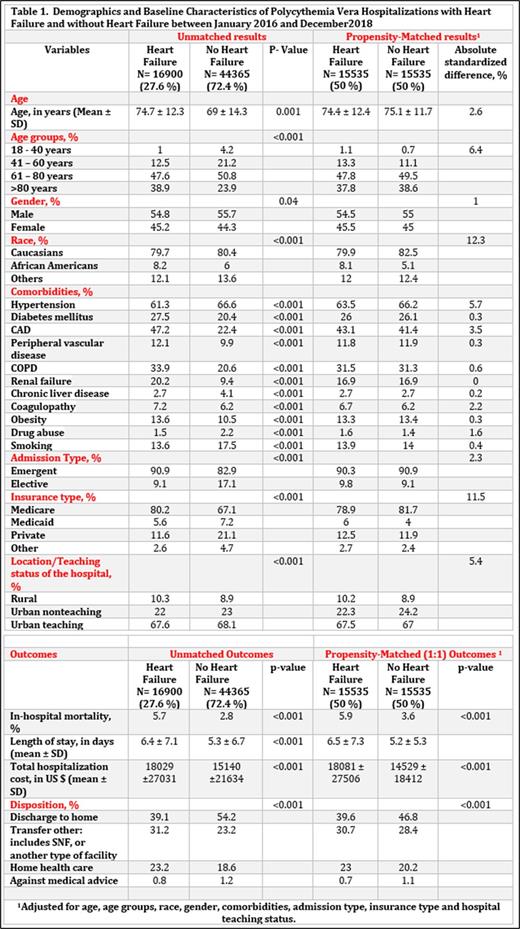Abstract

Polycythemia Vera (PV) is a rare chronic myeloproliferative disorder (MPN), a hematopoietic stem cell-derived malignancy that is characterized by clonal proliferation of myeloid cells with variable degrees of morphologic maturity. PV is distinguished from other MPNs by the presence of an elevated red blood cell mass (ie, erythrocytosis), and is associated with an increased risk for thromboembolic events, leukemic transformation, and/or myelofibrosis. This translates to sludging of blood flow due to hyperviscosity. Patients with PV have increased risk of both arterial and venous thrombosis as well as hemorrhage. Acute coronary syndrome and cardiac thrombotic events are well known complications of PV, however there is insufficient data on PV associated with heart failure (HF) and its repercussions. Through this study we aim to determine baseline characteristics of PV patients with and without HF and its impact on morbidity, mortality and overall hospital length of stay.
We identified all hospitalized adult patients with PV from the National Inpatient Sample Database between January 2016 to December 2018 using ICD-10-CM codes, and divided them into groups with and without heart failure. We compared patient's baseline characteristics, associated comorbidities, mortality, length of stay and hospitalization costs among PV patients with and without HF. Propensity-score 1:1 matching for age, sex, race, and co-morbidities was performed among both groups. SAS 9.4 software was used for statistical analysis.
Out of 61265 patients hospitalized with PV, 16900(27.6%) patients were found to have HF. The patients in HF group were noted to have higher mean age (74.7±12.3 vs 69±14.3 years), and higher prevalence of comorbidities such as diabetes mellitus (27.5 vs 20.4%), coronary artery disease (47.2 vs 22.4%), peripheral vascular disease (12.1 vs 9.9%), chronic pulmonary obstructive disease (33.9 vs 20.6%), Renal failure (20.2 vs 9.4%) and obesity (13.6 vs 10.5%). In terms of propensity matched outcomes, the group with PV and coexisting HF had higher inpatient mortality (5.9 vs 3.6%), higher total length of stay (6.5 ± 7.3 vs 5.2 ± 5.3 days), and higher total hospitalization cost (18081 ± 27506 vs 14529 ± 18412 $) (p<0.001).
Our study noted that almost 27.6% of hospitalized PV patients had concurrent HF. We observed that presence of HF in patients with PV significantly increased mortality, hospitalization costs and total length of stay. Despite major advances in Heart failure (HF) treatment strategies, morbidity and mortality remains high. With regard to the etiology, there are different causes of HF, and their recognition can be crucial for treatment optimization. With mounting epidemiological evidence of association and fatal outcomes, our study also shines light on a significant knowledge gap in the field of MPN such as PV and concurrent HF, and warrants further studies to better delineate pathogenesis and early diagnostic and treatment strategies specifically curated for PV associated HF.
No relevant conflicts of interest to declare.
Author notes
 This icon denotes a clinically relevant abstract
This icon denotes a clinically relevant abstract


This feature is available to Subscribers Only
Sign In or Create an Account Close Modal